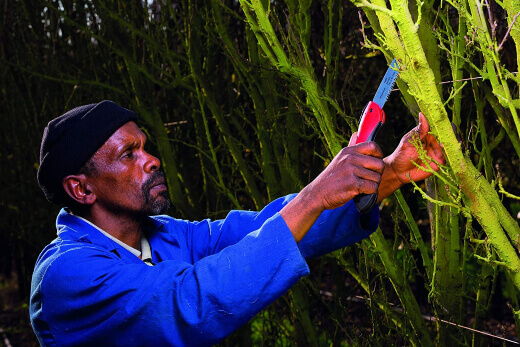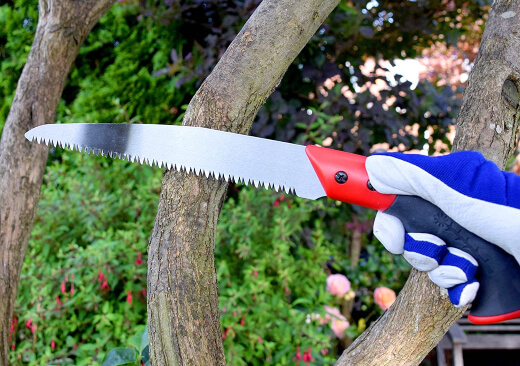If you have trees and shrubs in your garden, then a pruning saw is an essential item for your gardening toolkit! They easily take care of tree limbs that are too thick for garden loppers, can cut around awkward angles, and are specifically designed for pruning living plants.
More...
Best Value

Premium Choice

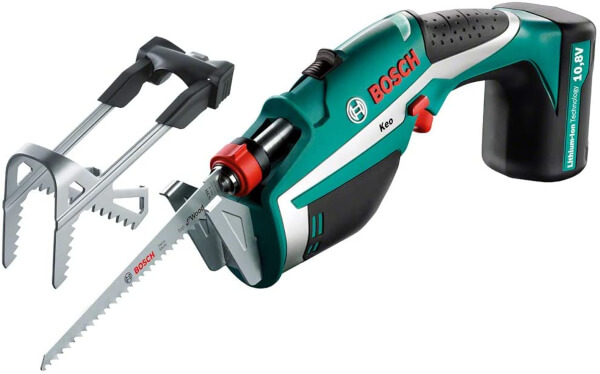
Best Pruning Saws for 2025
Product | Our Rating | Price | |
|---|---|---|---|
1. Felco (F 600) - Classic Folding Tree Pruning Saw |  | ||
2. Bosch Cordless Garden Pruning Saw Keo |  |  | |
3. Felco Model 600 Pruning Saw |  | ||
4. Spear & Jackson Folding Pruning Saw - SJ-4948PS |
Here are my recommendations for the best pruning saws in Australia, as well as tips on how to use, store and maintain your pruning tools.
What is a Pruning Saw?
Garden loppers can take care of thin limbs on trees and shrubs that are about 1.5cm-3cm in diameter. For anything thicker, you’ll need a tougher tool – and that’s where a pruning saw is useful.
It is also a very useful pruning tool for cutting branches that are at awkward angles or are in positions that are difficult to reach, especially if it has a shorter handle.
Different Types of Pruning Saw
As with most gardening equipment, there are a few varieties of this type of saw for different jobs.
- Manual saw – A manual pruning saw is one where you have to use your own power to cut through the limb. This isn’t a problem for most gardeners if you have a good quality blade, but if you have arthritis or less arm/upper body strength, an electric model will be better for you.
- Electric saw – An electric pruning saw has a motor that drives the action of the saw, making cutting much easier. They are usually battery powered for convenience and portability.
In this article, we’re going to be looking at the manual saws.
- Pole pruning saws – These saws have a long handle, allowing you to reach up and saw branches above you. Look for one with a rotating head, as they can be adjusted to cut odd angles more easily.
- Handheld saw – These are the most common pruning saws as they are very versatile and easy to use, especially if you are working on smaller plants and shrubs. They offer better control than pole saws too.
- Straight blade saw – This design works well for thin branches where you want to get an even back and forth motion while cutting.
- Curved blade saw – This is the best option for thicker branches, allowing you to cut in a single motion. The curved blade create a much cleaner cut, which helps prevent the cut site from dying back or becoming infected by bacteria.
Features to Look for in the Best Pruning Saw
- Blade quality – The blade is the workhorse of the saw, so it has to be good quality tempered steel. This will ensure that the teeth stay sharper for longer, that they don’t damage or break easily, and they can tackle hard wood.
- Foldable – Foldable pruning saws are very convenient, as they take up less space, are safer (the blade is shielded, so you can’t accidentally cut yourself when it’s stored), and tend to last longer, as the teeth are shielded so they stay sharper.
They tend to cost a little more, but are worth the price. - Replaceable blades – No matter how carefully you use and store your pruning saw, the blades will eventually become blunt. They can usually be sharpened a few times, but will need replacing in time.
If the saw doesn’t have replaceable blades, you’re going to have to pay for an entirely new pruning saw. In the long term, this is much less affordable than buying a pruning saw that has replaceable blades. - Tri-cut functionality – The name of this feature changes from brand to brand, but it essentially refers to the fact that the saw blades are sharpened on 3 sides, like a triangle. This makes sawing easier and faster, as the saw is able to cut on both the push and pull stroke.
- Easy to clean – Because you are using your saw on live trees and shrubs, it’s going to quickly get sticky with sap, which can clog the blades. The best pruning saws are designed with this in mind, and are made with either non-stick or low-stick teeth that will keep on cutting even when covered by tree sap.
- No plastic – Some manufacturers use plastic parts on their saws to help make the product cheaper. However, this affects the durability of the saw, so don’t expect it to last as long.
Plastic makes the tool cheaper but it is also rare for tools with plastic to go the distance and last many years. In fact, in many cases, manufacturers make tools out of plastic BECAUSE they won’t last for years, forcing you to buy tools again and again.
How Much Do the Best Pruning Saws Cost?
Because they are made from the best quality materials, the best pruning saws cost a bit more than the rest – but they are worth it in the long run because they last.
Pruning saws range in cost from about $20 right up to $200. To get a folding pruning saw with a tri-cut blade you are probably looking around the $50 mark.
Spending $60-70 will get you a top-notch tool, spending $30-40 will get you a serviceable tool. Spending less than $30 and you are probably getting a tool that will last a season or two before you have to spend another $20-$30 on a new tool.
Maintaining Your Pruning Saw
These saws require a little maintenance to keep them in working order.
- Cleaning – Clean your saw well after use, washing it with dishwashing liquid to get rid of the tree sap. You can use a 10% bleach solution to sterilise them. Dry them well and then spray with oil to prevent rust.
- Sharpening – Check the blades to ensure that they are sharp and secure in the handle. Sharpen once a season before use and replace the blades as needed.
- Store – Pack away or fold up your saw somewhere dry, our of the sunlight and out of reach of children, in your garage or garden shed.
Safety Tips for Using a Pruning Saw
The best pruning tools are very sharp, so it’s important to take safety precautions when using them.


Get Your Free Guide:
Master Growing Australian Natives eBook
A Must Have Complete Guide for Every Australian Garden
Get Your Free Guide:
Master Growing Australian Natives eBook
A Must Have Complete Guide for Every Australian Garden
- Protective clothing – Wear closed, sturdy shoes, thick gardening gloves and a long-sleeved top and pants. If you are working in or under a tree, especially with a pole pruning saw, be sure to wear a hard hat and eye protection.
- Sharpen the blade – Check your saw blade on a small branch to see if it requires sharpening and to make sure it is firmly attached to the handle. A blunt blade can be incredibly dangerous, as it can slip while cutting a branch.
- Position – Stand close to the branch you are cutting rather than reaching beyond a comfortable limit. This gives you better control while cutting. Make sure your feet are in a sturdy, secure position, especially if you are on a ladder.
- Consider your cut – Look at how you are going to cut the branch to determine how the branch will fall. Make sure you are not in the way of the falling branch, and that there is no risk of the branch causing damage to a person or property.
How to Use a Pruning Saw
When you have your pruning saw, it is important to use it correctly so that the tree or shrub flourishes and isn’t damaged.
- Where to cut – A good pruning cut is just beyond the growth point or branch collar. You can see this as a slightly swollen or ridged area where the branch is attached.
This will allow new bark to seal off the cut from disease and bacteria. Never cut flush against a trunk, as this will damage the tree.
If you cut too far beyond the collar, the branch will die back to the collar and create dead wood that attracts pests and disease. - How to cut – Hold the branch with your non cutting hand a reasonable distance from the saw blade to avoid hurting yourself.
Pace the blade where you would like to cut and start by pulling it towards you slowly to make a ridge where the teeth can grip. Cut with slow back and forth motions, using the full length of the saw.
Don’t rush or force the saw, as this can make it slip dangerously. Only release the branch when the cut is complete, not before, as the bark may tear.
Pruning Saw Reviews for 2025
1. Felco (F 600) - Classic Folding Tree Pruning Saw

Source: Amazon
The Felco 600 folding pull stroke pruning saw's conical blade and skillfully designed teeth geometry removes clogging and sap build-up for high-performance cutting of large diameters.
2. Bosch Cordless Garden Pruning Saw Keo

Source: Amazon
Easily cuts branches up to 80 mm with one push of a button.
3. Felco Model 600 Pruning Saw
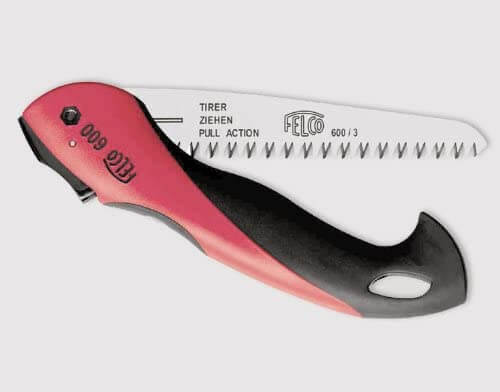
Source: Amazon
Can cut branches up to 4 inches in diameter.
4. Spear & Jackson Folding Pruning Saw - SJ-4948PS
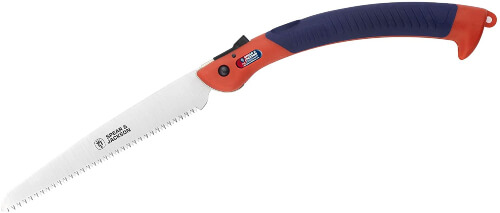
Source: Amazon
Built with Sk5 carbon steel blade for long lasting sharpness.
Our Top Picks - Best Pruning Saws in Australia
Best Value Pruning Saw


Source: Amazon
In terms of value for money, it’s hard to beat the Felco (F 600) - Classic Folding Tree Pruning Saw. It’s a fully-manual saw so there’s no need to worry about the cost of batteries or having to recharge while you work.
The soft-grip, non-slip handle is functional and comfortable, and the 35cm, heavy-duty blade is made from high-quality rust-resistant steel.
It easily folds in half, so it’s easy to carry in your pocket, and it’s designed to minimise clogging and sap build-up as you saw.
Premium Choice Pruning Saw


Source: Amazon
If you’re happy to pay a little extra to get a lot more, we recommend the Bosch Cordless Garden Pruning Saw Keo! It easily cuts through branches of up to 80mm with the push of a button, supplying plenty of power to cut through tough and green wood.
You get a practical 30-190 cuts per charge from the lithium-ion battery and high-quality steel blade, and the soft grip handle and ergonomic shape keeps you comfortable as you work.
It also has a quick-stop feature and handguard for safety, and the AGrip can be removed to turn this multi-function tool into a reciprocating saw.
Pruning Saw Frequently Asked Questions
What type of saw is best for pruning trees?
Pruning saws are the best type of saw for pruning trees. They are designed to cut small to medium-sized branches and are lightweight enough to be worked with up ladders. Their blades cut in both directions, making quick work of fresh or sappy branches too.
How thick a branch can a pruning saw cut?
Pruning saws can cut branches up to about 20-25 cm thick. Smaller branches can often be cut with loppers more quickly, and more mature growth will need a chainsaw, or a larger tree saw to work through anything bigger than 35-40 cm across.
What is the best length for a pruning saw?
Pruning saws need to be long enough to accommodate the branch you are cutting, plus swing back. To cut a medium-sized branch (20-25 cm thick) you’ll need a saw that’s at least 30-35 cm long, otherwise, you’ll get stuck on every push and pull.
Why are pruning saws curved?
Pruning saws with a curved blade keep a better grip on the branch while you are cutting, which is better for cutting efficiency and safety, particularly if you are up a ladder as the curved blade keeps more stability against the weight of the branch.
Can I use a hand saw for pruning?
Pruning saws are the best tool for pruning trees, with their curved blades and back-and-forth teeth, but if you don’t have one you can cut through most small branches with a standard saw.
Just make sure you are steady on any ladders and hand saws have more flexibility and less grip on the branch.
Is a curved pruning saw better than a straight one?
Curved pruning saws are much better than straight pruning saws and cut more effectively, cleanly and efficiently. However, straight or flat-blade pruning saws are useful in small spaces where pruning is difficult, and often fold away neatly into your pocket to make climbing safer.
What saw to cut thick tree branches?
Tree pruning saws are the best tool to cut through thick branches safely, but if you’re trained and confident in using them, chainsaws are faster on very mature growth.
Do you prune at an angle or straight?
Always keep your cuts at a 45-degree angle when pruning trees and shrubs. This reduces the chance of the branch snapping while cutting, and allows rain to flow off, rather than sit on the surface of the cut, which is better for the health of the tree.
Can you prune too late?
Pruning trees in winter can harm them, so aim to prune for new growth in spring or late autumn, and to stunt growth in summer. Pruning in winter exposes fresh cuts to frost damage.
Can pruning saw blades be sharpened?
You can sharpen any saw by hand using simple hand sharpening tools, but tree pruning saws can be challenging to sharpen. You will need to follow the direction of the teeth, downwards on both sides for an even sharpening, rather than the usual one-directional motion to sharpen hand saws.
Do you prune above or below a node?
Pruning below a node can stunt the growth of a tree and will create an unsightly stump. Pruning above a node promotes more natural recovery, with new branches forming from the cut point.

Get Your Garden in Shape with the Best Pruning Saws in Australia
The best pruning saw is a versatile tool that any gardener will get great use out of throughout the seasons. Ideal for use on living limbs that are too big for your garden lopper, your tempered steel pruning saw will create clean, easy cuts that make shaping and managing your trees and shrubs simple.
Remember to follow our safety, usage, maintenance and storage tips to keep your pruning tools in great shape and make sure your investment in the best pruning saw lasts a lifetime!
Published on January 25, 2023 by Gary Clarke
Last Updated on December 23, 2025

